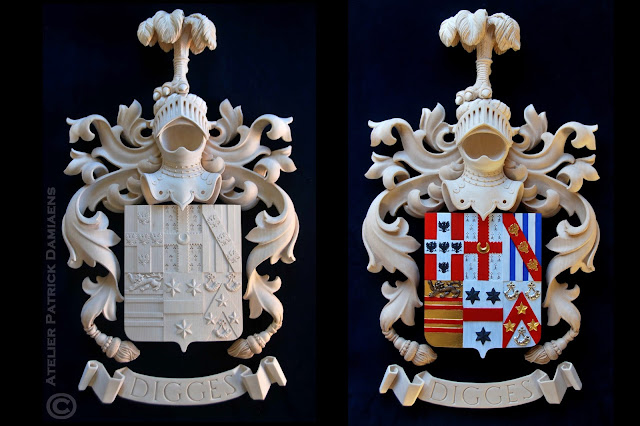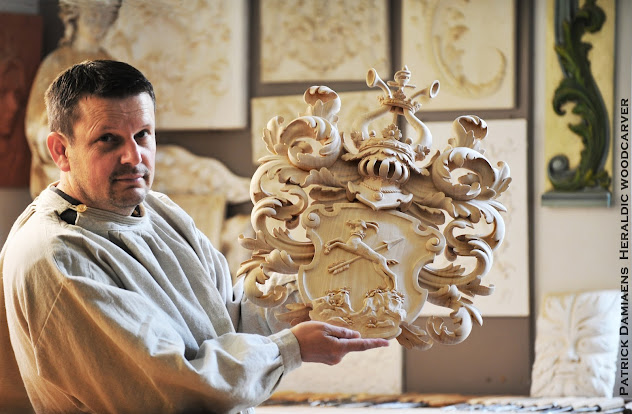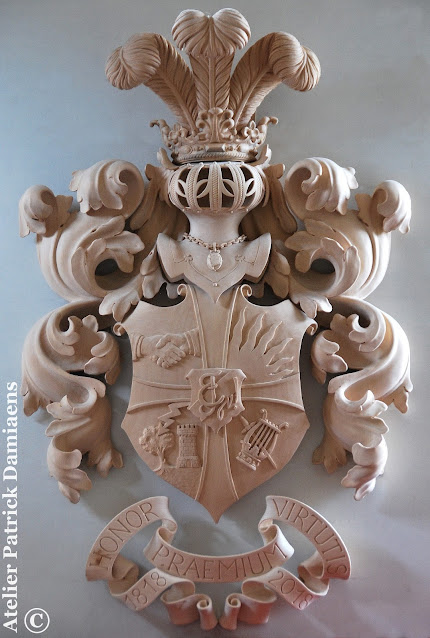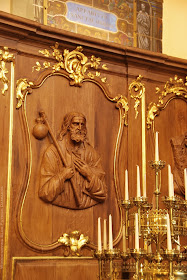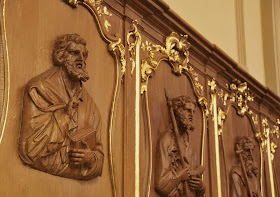 |
| The CROISIERS CHURCH |
Order of
the Holy Cross, Crutched Friars
Canons Regular of the Order
of the Holy Cross
in the historical city centre of MAASEIK
A
church interior in Rococo
We’ve
already dedicated many blog items to incredibly beautiful and interesting
museum collections, castles and religious buildings, which could mostly be
found abroad. However, in this blog item, we’re staying a bit closer to home,
namely in my own hometown, the city of Maaseik.
In the historical city centre, we pay a little visit to the
Church of The Canons Regular of the Order of the Holy Cross, commonly called Crosiers, also known as Saint-Jacob’s Church, situated in
the Bosstraat. It is endowed with one of the most beautiful church interiors in
Rococo in the entire province of Belgian Limburg.
 |
| A church in the historical Town of MAASEIK |
Canons Regular of the Order of the Holy Cross
The Order of the Holy Cross was founded in the first half of the thirteenth
century. These “Brethren of the Cross”, as the first Crutched Friars called
themselves, wandered around preaching the word of God, and wherever they
lingered, a small religious community arose. Most of these communities didn’t
last long though.
Yet, in
the principality of Liège, where a devout following of the Holy Cross had
existed for quite some time already, certain communities managed to survive.
They settled near the edge of a town and/or kept in close touch with the
noblemen who owned the land along the trade routes.
These noblemen built a
chapel for themselves and a hospital for weary travellers and pilgrims and were always looking for
priests to celebrate mass and look after the hospital.
In 1248,
a number of communities of the Brethren of the Cross decided to join into one
order of regular canons.
That same year, the pope approved of the creation of
the order, thus establishing the Order of the Holy Cross.
By the
end of the thirteenth century, the order consisted of quite a few monasteries
in the principality of Liège and the rest of “Belgium”, but also abroad,
including in France, Germany, The Netherlands and England. After receiving a
number of privileges the legal position of the Order was strengthened,
and slowly but surely, the monastery of Huy worked its way up to become the
official “headquarters”.
 |
| A Croisiers Church in Belgium | Maaseik |
In 1767,
prior Johannes Henricus Vossen ( †1770) commissioned the construction of
the Saint-Jacob’s Church. The new church replaced the old Saint-Jacob’s chapel,
a late gothic building that was torn down. This old building was described in
‘Les Délices du Pays de Liège’: “The church is beautiful and appealing, even
though it was erected in the style of the former period, and ends in a round
vault which is supported. The nave is lower and, as with the side aisle,
completely plastered. The interior as a whole is quite lovely and is adorned
with four painted and gilded altars in Corinthian style”. The new Saint-Jacob’s
Church, which was built by Josef Couven from Aachen, is a church with a single
nave in the style of Louis XV or Rococo.
Construction
of the present church
On the
eve of the French Revolution, Maaseik counted no less than 6 religious orders.
Their monasteries were located inside the city walls, but outside the city
centre, at the edge of town near the city gates. This allowed each of the
monasteries to map out their own territory, as it were. The monastery churches did
not have a church tower, but had a roof-turret instead. A small steeple with a
bell in it was more than enough for the monastery and the locals. The
Saint-Jacob’s Church of the Crutched Friars still has such a roof-turret. From
the outside, this church comes across as quite uninspired and dull. It’s hidden
among the rows of houses near the building line and has become a part of the
street façade.
The
church has an arched portal in a rectangular block-shaped frame, consisting of
limestone and adorned with a keystone and a stalactite-shaped stone. The
keystone bears the chronogram “in CrUCe MunDI saLUs” (the cross holds the
sake of the world).
 |
| The entrance |
 |
| “in CrUCe MunDI saLUs” |
In 1797,
the monastery of the Crutched Friars was abolished by the French and the
monastery buildings were torn down. The church, however, joined the parish of
Maaseik. In 1856 it was sold to the Crutched Friars, who had returned at that
time.
Rococo
interior
The
beautiful Rococo interior, with adorable stucco and plastering, contrasts
sharply with the exterior. The interior of the Church of the Crutched Friars is
exactly the reason why this is one of the most beautiful churches in the
province of Limburg. The vaulting consists of vaulting cells in between the
ribs, which are supported by columns with Doric and Ionic capitals.
The
chancel area is covered by fan vaulting. In the stucco in between the arches we
see the devotions of the Crutched Friars of Maaseik.
 |
| Doors, Rococo style |
Rocaille
patterns, characteristic of the Rococo style, were applied in abundance on the
vaulting, façades, the arcades and the furniture. Pay particular attention to
the large variety of patterns, which were all applied on site in the wet
stucco.
Chancel
The
sober wooden baroque altar originates from the old church. The altar of
St-Peter’s cathedral in Rome, with its four columns and canopy, served as a
model for this sort of altars stemming from the 17th and 18th
century. Due to a lack of space, the front columns were moved to the back and
ended up next to the rear columns (Corinthian columns). A broken arch
consisting of three segments replaces the large canopy.
The
altar piece is a magnificent painting attributed to the Antoon van Dijck
School. It is a depiction of the crucified Christ with Mary Magdalene and a
Crutched Friar (Theodorus van Celles, the founder of the Crutched Friars or
Augustinus Nerius, the master at that time) in an ecstatic pose with staff, mitre and sword. The cross of the order
and the proverb “In Cruce Salus” (the cross holds the sake) complete the
tableau.
On
either side of the altar, two cabinets are mounted on the wall, holding relics
of the Holy Odilia. The stained-glass window to the left of the altar we see
the apparition of the Holy Odilia to the Crutched Friar Joannes van Eppa, who
was commanded by her to bring her relics from Cologne to Huy.
On
either side of the chancel and in the back of the church, we find oak doors
with charming examples of woodcarving, not of the highest standard, but
definitely worth mentioning, notably the flower and leaf motifs on the
structural parts of the doors and the shell motifs on the panels.
 |
| Organ railing, Rococo style church interior |
Rood
loft
The
present organ dates back to the end of the 19th century, but a positive was
built into the organ railing, which probably originates from the earlier
Saint-Jacob’s Church. The railing is richly adorned. It has depictions of
flutes, clarinets, oboes, violins, kettledrums, etc. in stucco.
The entire
structure, hanging from fluttering ribbons and wreathed with flowers and leafs,
shows great craftsmanship. On either side the organ is adorned with statues of
the Holy Augustine and the Holy Helena, who’s presumed to have held a cross in
her left hand, originally.
During
restorations in 2008-2009, the church wasn’t just repainted in its original colours, but also remarkably embellished.
For example, the 19th century pulpit, parts of which served as an
altar and others as a lectern for several years, can now be admired in its
original place and in its original shape, no less.
Here are a few pictures of the stucco!
Adorned
by Mertens (native of Antwerp), the chancel with busts of the 12 apostles on
either side, stucco with an elegant frame in neo Rococo style.
 |
| ROCOCO Church Interior |

